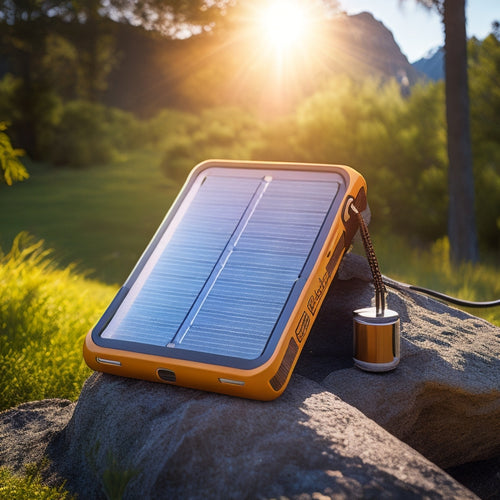
How to Calculate Home Battery System Costs
Share
When calculating home battery system costs, you'll need to factor in components like batteries, inverters, and monitoring systems. Assess your energy usage patterns and appliance types to determine the required battery capacity. Research and compare prices for solar panels and inverters, considering efficiency ratings and warranty durations. Choose a suitable battery type and brand, evaluating factors like performance, support, and warranty. Installation costs will depend on labor rates, permits, and complexity factors like system size and electrical integration. Don't forget to investigate incentives like the Solar Investment Tax Credit and utility rebates – and as you delve deeper, you'll uncover more subtleties to guarantee a cost-effective and efficient home battery system.
Overview
- Calculate battery capacity requirements based on energy usage patterns and appliance types for backup needs.
- Consider costs of solar panels and inverters, including efficiency ratings and prices, to optimize system selection.
- Evaluate battery type and brand selection based on warranty, support, and performance metrics to ensure reliability.
- Factor in installation costs, including labor rates, permits, and inspection fees, to estimate total system expense.
- Research financial incentives, such as government programs and utility rebates, to maximize savings and reduce upfront costs.
Understanding Home Battery System Components
Typically, a home battery system comprises several key components that work together to provide efficient and reliable energy storage.
You'll need to evaluate the type and quality of batteries, such as deep cycle batteries or lithium-ion energy storage systems, which directly impact the system's overall performance and lifespan off-grid reliability.
Battery lifespan evaluations, such as depth of discharge and charging cycles, are vital in determining the system's durability. Additionally, lithium-ion energy storage systems focus on safety and advanced grid integration for efficient energy management.
Your energy usage patterns also play a significant role, as they influence the system's ability to meet your energy demands.
Other essential components include an inverter/charger, which converts DC power to AC, and a monitoring system, which tracks the system's performance and alerts you to any issues.
Calculating Battery Capacity Requirements
Several factors influence the calculation of battery capacity requirements for your home battery system.
You'll need to take into account your energy usage patterns, the size and type of appliances you want to power, and the desired backup time during an outage.
To accurately estimate your battery size requirements, you'll need to conduct an energy usage analysis, which involves Load Analysis to assess system requirements and storage capacity for peak demand.
This analysis will help you identify areas where you can optimize your energy usage and reduce your reliance on the grid.
With this data, you can perform a battery size estimation to determine the minimum capacity required to meet your energy needs.
A thorough energy usage analysis will guarantee you get the right-sized battery for your system, providing you with the freedom and independence you desire.
Cost of Solar Panels and Inverters
As you design your home battery system, you're likely wondering about the cost of the solar panels and inverters that will charge your batteries. These components are essential, as they convert sunlight into electrical energy. The cost varies depending on the type and quality of the solar panels and inverters.
| Component | Low-End Cost | High-End Cost |
|---|---|---|
| Solar Panels (250W) | $250-$300 | $400-$500 |
| String Inverter | $1,000-$1,500 | $2,000-$3,000 |
| Microinverter | $1,500-$2,500 | $3,500-$5,000 |
When selecting solar panels, consider the efficiency rating, which affects the amount of energy generated per unit area. Inverter types include string inverters, microinverters, and power optimizers, each with their own advantages and disadvantages. Be sure to research and compare prices to find the best option for your system.
Battery Type and Brand Selection
When selecting a home battery system, you'll need to evaluate the type of battery chemistry that best suits your needs, whether it's lithium-ion, lead-acid, or another option.
You'll also want to compare different brands, analyzing factors like their warranties, support, and overall performance.
Top-rated solar battery brands such as Tesla and LG are known for their innovative technology and performance, and often offer extensive warranty options.
Battery Chemistry Options
By now, you've likely realized that selecting the right battery chemistry is an essential step in designing a home battery system that meets your specific needs. The choice of battery chemistry greatly impacts your system's performance, cost, and environmental footprint. You'll want to take into account factors like energy density, cost efficiency, and temperature sensitivity when making your decision.
| Battery Chemistry | Characteristics |
|---|---|
| Lithium-Ion | High energy density, long lifespan, recyclable, but expensive |
| Lead-Acid | Low cost, well-established, but heavy, low energy density, and toxic |
| Flow Battery | Long lifespan, scalable, but low energy density, and high upfront cost |
| Sodium-Ion | Promising alternative to lithium-ion, but still in development |
| --- | --- |
When evaluating these options, reflect on the lithium advantages, lead acid drawbacks, flow battery benefits, and sodium ion possibilities. Think about the battery lifespan, environmental impact, and recycling options. By assessing these factors, you'll be able to choose the best battery chemistry for your home battery system.
Brand Comparison Analysis
You've narrowed down your battery chemistry options, and now it's time to investigate the world of brand comparison analysis. This essential step helps you identify the best brand for your home battery system.
Start by researching brand reputation, customer reviews, and performance metrics to gauge each brand's reliability and efficiency. Compare warranty packages, service options, and compatibility factors to guarantee seamless integration with your existing system.
Probe into installation experiences and reviews to get a sense of the brand's support and professionalism. Finally, analyze price fluctuations and compare costs to determine the best value for your money.
Warranty and Support
A home battery system's warranty and support package can make or break your investment, as it directly impacts the system's overall reliability, maintenance costs, and lifespan.
You'll want to scrutinize the warranty duration, which can range from 5 to 15 years or more, depending on the manufacturer. A longer warranty typically indicates higher quality and lower maintenance costs.
Additionally, consider the support options, such as phone, email, or online chat support, as well as the availability of local authorized service providers.
Some manufacturers may also offer extended warranty options or premium support packages for an additional fee.
When evaluating warranty and support, ask yourself: What kind of protection do I need for my investment, and what level of support am I willing to pay for?
Installation and Labor Costs
When calculating installation and labor costs for your home battery system, you'll need to take into account the fees associated with obtaining necessary permits and passing inspections.
You'll also need to factor in the labor hourly rates of the installation team, which can vary depending on their knowledge and location.
Additionally, the complexity of the installation, including factors like system size and integration with existing infrastructure, will impact the overall labor costs.
Permits and Inspections
Obtaining necessary permits and passing inspections are essential steps in the home battery system installation process, as they guarantee the system meets local building codes and safety standards.
You'll need to research and comply with local regulations, which vary by region, to determine the required permits for your project. Factor in the cost of these permits, as well as the time and effort involved in obtaining them.
Inspection timelines also impact your project's overall timeline, so be sure to plan accordingly. Typically, inspections occur at various stages of the installation process, including during and after the installation.
You'll want to budget for potential re-inspections if any issues arise.
Labor Hourly Rates
In conjunction with permits and inspections, labor hourly rates greatly impact the overall cost of your home battery system installation.
When calculating labor costs, you'll need to take into account the labor market in your area. Regional differences in labor rates can greatly influence your total installation cost. For example, electricians in urban areas tend to charge higher hourly rates than those in rural areas.
On average, labor hourly rates for electricians in the US range from $75 to $150 per hour. You'll need to research the going rate in your area to get an accurate estimate.
Be sure to also factor in the number of hours required for installation, which can vary depending on the complexity of your system.
Installation Complexity Factors
Your labor hourly rate research sets the stage for calculating installation complexity factors, which greatly impact your home battery system's installation and labor costs. These factors depend on system design and installation techniques. As you evaluate your home battery system, consider the following installation complexity factors:
| Factor | Description | Complexity Level |
|---|---|---|
| System size | Number of batteries and components | Low to High |
| Installation location | Ease of access, obstacles, and environmental factors | Low to High |
| Electrical integration | Complexity of electrical connections and system integration | Medium to High |
| Permits and inspections | Number and complexity of required permits and inspections | Low to Medium |
These factors will influence your installation costs, so it is crucial to assess them accurately to get an accurate estimate of your home battery system's total cost.
Incentives and Rebate Opportunities
Through government programs and utility company initiatives, you can greatly reduce the upfront cost of a home battery system by taking advantage of available incentives and rebate opportunities.
Federal incentives, such as the Solar Investment Tax Credit (ITC), offer a tax credit of up to 30% of the total system cost. Additionally, state rebates and local government initiatives can provide further discounts.
You may also be eligible for energy efficiency rebates from your utility company, which can help offset the cost of your home battery system.
Be sure to research and investigate these opportunities to maximize your savings and achieve energy independence.
Ongoing Maintenance Expenses
Battery system upkeep requires a budget for ongoing maintenance expenses, which can add up over time.
You'll need to take into account the maintenance frequency, which typically involves inspecting and testing your system every 6-12 months. This guarantees your system operates efficiently and identifies potential issues before they become major problems.
Performance monitoring is also essential, as it helps you track your system's output and detects any anomalies.
When calculating maintenance expenses, factor in repair costs, which can vary depending on the type of issue. Additionally, take into account the replacement timeline for components like batteries, which typically need to be replaced every 10-15 years.
Frequently Asked Questions
Can I Use a Home Battery System Without Solar Panels?
You can use a home battery system without solar panels, still enjoying benefits like energy independence and reduced grid reliance; however, you'll need to charge it from the grid, diminishing some of the system's overall value.
How Long Does It Take to Pay off a Home Battery System?
Like Odysseus steering through treacherous seas, you're charting a course to energy independence. Your home battery system's payback period depends on energy savings, which can take 5-10 years to materialize, but with careful planning, you'll be sailing smoothly towards freedom from utility bills.
Do Home Battery Systems Increase Property Value?
You'll be pleased to know that installing a home battery system can enhance your property's value, as a property appraisal will reflect the added benefit of energy independence, increasing your home's appeal to potential buyers who crave freedom from grid reliance.
Are Home Battery Systems Compatible With Grid-Tied Systems?
You're wondering if home battery systems are compatible with grid-tied systems, allowing you to maintain grid independence while still drawing energy from the grid when needed, thereby enhancing your energy resilience and overall freedom.
Can I Install a Home Battery System Myself?
You can attempt a DIY installation, but be aware that it's essential to prioritize safety considerations, like proper electrical connections and ventilation, to avoid risks and guarantee a reliable home battery system that gives you the freedom you desire.
Ready to Buy
You've crunched the numbers and now have a clear understanding of the costs involved in installing a home battery system. Don't let sticker shock discourage you - remember, the long-term benefits of energy independence and reduced utility bills will pay off in the end. Plus, with the right incentives and rebates, your upfront costs can be greatly reduced. Take the next step and start planning your home battery system today.
Related Posts
-

Net Metering in Renewable Energy's Future
Net metering's future is vital for driving renewable energy growth and financial savings. You can reduce your electri...
-

Cost of Solar Panel Installation
You can expect to pay between $15,000 and $30,000 or more for a typical solar panel installation, depending on the sy...
-

Fastest Solar Chargers for Emergency Power
When choosing the fastest solar chargers for emergency power, you need to focus on features like rapid charging capab...


